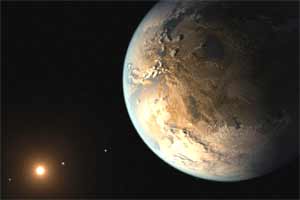NASA is closer than ever to finding a twin for the Earth, said astronomers. (Reuters)
NASA is closer than ever to finding a twin for the Earth, astronomers said on Tuesday, announcing the discovery of eight new planets that circle in the habitable zones of their stars.
Two of the eight are the most Earth-like of any known planets found so far outside our solar system, astronomers told the 225th meeting of the American Astronomical Society in Seattle, Washington.
The pair are likely to have hard, rocky surfaces in addition to being an orbiting distance from their stars that is neither too hot nor too cold for water and possibly life to exist, astronomers said.
The discovery doubles the number of known planets that are close in size to the Earth and believed to be in the so-called “Goldilocks zone” of the stars they orbit.
To-date, 8 small Kepler verified exoplanets are close enough to their stars to possibly sustain water. #AAS225 pic.twitter.com/RcZTkDwNhM
— NASA Kepler (@NASAKepler) January 6, 2015
Remember – the @NASAKepler field of view is only a tiny slice of our galaxy. There are a LOT of planets out there! pic.twitter.com/prjNujuoKB
— Jason Major (@JPMajor) January 6, 2015
Scientists have recently verified the existence of the 1,000th planet found by Kepler.
“Three of the newly validated planets are located in their distant suns’ habitable zone, the range of distances from the host star where liquid water might exist on the surface of an orbiting planet,” NASA said in a statement.
“Of the three, two are likely made of rock, like Earth.”
(1/2) Of the 3 new small exoplanets close enough to their stars to possibly sustain water, 2 may be rocky like Earth. #AAS225
— NASA Kepler (@NASAKepler) January 6, 2015
While it is intriguing to consider the possibility of life existing on another planet like ours, the two best candidates are so far away that learning more about them presents a big challenge.
